Solar Energy Firm’s Bankruptcy Calls Obama’s “Green Jobs” Program Into Question
The failure of a solar energy firm in California is raising questions about a centerpiece of the Administration's economic policy.
Ordinarily a Chapter 11 filing by yet another solar energy firm would not be news, bankruptcies in the industry are rather common it seems. However, the bankruptcy filing by a Silicon Valley firm yesterday is raising questions about the Obama Administrations “Green Jobs” program, and leads one to wonder why the Federal Government is providing loan guarantees to companies in an industry with a history of insolvency:
WASHINGTON — A Silicon Valley maker of solar power arrays that was started with high hopes and $527 million in loans from the federal government said on Wednesday that it would cease operations. The failure of the company — and the loss to taxpayers — is likely to renew the debate in Washington about the wisdom of clean energy subsidies and loan guarantees.
President Obama praised the company, Solyndra, for its advanced technology during a visit last year. But in a statement on Wednesday, Solyndra said its business had run into trouble because of difficult global business conditions, including slowing demand for solar panels, and stiff competition.
The Energy Department, which approved the funding, said China’s subsidies to its solar industry were threatening the ability of Solyndra and other American manufacturers to compete. The price of a solar array, measured by cost per watt of capacity, has fallen 42 percent since December 2010, the agency said.
Two other American solar companies, Evergreen Solar and SpectraWatt, also sought bankruptcy protection in August, and both said competition from Chinese companies had contributed to their financial problems.
In the case of Solyndra, some experts said that regardless of the competition, the company’s unique designs, which were expensive to manufacture, were to blame for its failure.
Solyndra was promised loans of up to $535 million under a guarantee program authorized by Congress as part of the 2009 stimulus package. The Energy Department has made more than 40 promises of guarantees, of which Solyndra was the first. It has committed $18 billion in guarantees and expects to allocate several billion dollars more by the time the program finishes at the end of September.
The government calculates premiums for the guarantees, essentially a loan fee based on the risk of default, but it picks up the cost of the premiums for the companies in the subsidy program. By that yardstick, it has spent $2.4 billion in credit subsidies for the program.
This was not a typical government guaranteed loan. Rather than being provided by a commercial bank and guaranteed by the government, the loan was provided by the government itself through an entity known as the Federal Financing Bank, a division of the Treasury Department. In essence, then, the program was loaning taxpayer dollars to these companies with one hand, while guaranteeing the repaying of these loans to the FFB, also with taxpayer dollars, with the other. Neither Solyndra nor any of the other companies that benefited from these “loans” (it’s really more appropriate to call them gifts) assumed any risk. All the risk was assumed by the American taxpayer, which makes the appallingly bad judgment that was apparently used here even more egregious.
In the case of Solyndra, one has to wonder how the company ever qualified for loan guarantees to begin with. The company has never recorded a profit in its entire history and earlier this year cancelled an expansion that was supposedly going to be financed in part by the loans received through the Obama Administration program. Just a year ago, PriceWaterhouseCoopers issued a scathingly negative report on the company two months before President Obama went there to tout the company as an example of his investment in “Green Jobs.” It leads one to question both the criteria that were used to determine who gets the loan guarantees to begin with, and the political judgment of the White House in choosing this particular firm to showcase the President’s economically dubious idea that subsidizing so-called “Green Jobs” will somehow create demand for “Green” products where it doesn’t currently exist.
At least one Member of Congress is raising questions about how Solyndra was able to qualify for this Federal gift despite having no record of actually making money, and plenty of reasons to doubt it could succeed:
“In an apparent rush to push stimulus dollars out the door, the Obama administration wasted $535 million in taxpayer funds in guaranteeing a loan to a firm that has proven to be unviable in the global market,” said Representative Cliff Stearns, the Florida Republican who is chairman of an investigative subcommittee of the House Energy and Commerce Committee.
He said the Energy Department might have authorized the guarantee because an Oklahoma oil man who was a donor to the Obama campaign, George Kaiser, was an investor in the project. In a joint statement, Mr. Stearns and Representative Fred Upton of Michigan, the chairman of the committee, said, “We smelled a rat from the onset.”
But the Energy Department dismissed that assertion, saying that Solyndra applied for federal help during the Bush administration and that Obama-era officials merely finished the process the Republicans had begun.n
That last bit, of course, doesn’t really answer the question of whether or not political connections inside the Obama Administration helped Solyndra gain approval for participation in the program, which apparently didn’t come until well after George W. Bush had left office.
As Bruce McQuain points out, this case is a microcosm of what happens when government tries to do something it isn’t designed or intended to do. Traditionally, start up companies like Solyndra start out by getting their initial working capital from a combination of the assets of the owners, private investors, and venture capitalists. Given that Solyndra is located in the center of the venture capital world, where tech companies that won’t show a profit for years are given money by VCs who believe that they’ll one day be something big. The number of tech companies that are household names today that started out this way is quite large. But venture capitalists are risking their own money, or the money of people who have entrusted them with the decision making authority to choose investments, and they’ve typically got experience in the industries in which they’re investing. More importantly, most large VC investments come with strings attached that include bringing in professional management, and otherwise guaranteeing that what started out as a project between friends is run professionally by people who make sound business decisions.
None of that is true when the decisions are being made by the government. For one thing, the people who make the decisions aren’t playing with their own money and they don’t owe any fiduciary or contractual obligations to the people whose money they are investing. If a VC makes a bad judgment on an investment, he either loses his own money or likely loses investors. If a government bureaucrat makes a bad judgment on a program like this, they’re unlikely to lose their job, they haven’t lost their own money, and all they need to do when the loan guarantee has to be paid is send the bill to Congress. They don’t have the incentive to make the right decisions, and they likely don’t have the experience either. And they’re playing with your money and mine.
One final point is worth noting. If Solyndra was not able to obtain venture capital funding in Silicon Valley of all places, that fact alone should have raised eyebrows. As it turns out there were significant problems with the company’s business model and its product design that were pointed out long before the loans were approved by Treasury. These concerns were either not known to the decision makers, or they were ignored in the name of helping a “Green” company. Neither choice is good.
NBC’s Bay Area affiliate calls the bankruptcy a political catastrophe for the President. While I’m not sure I would go that far, it is certainly Exhibit A in the case against the kind of “smart people” Industrial Policy that Democrats have longed to engage in for years, and which President Obama foolishly went forward with in the name of “Green Jobs.”
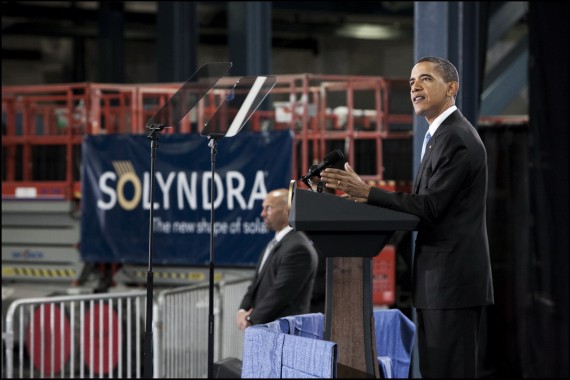

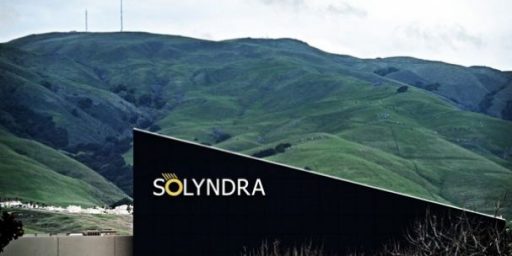
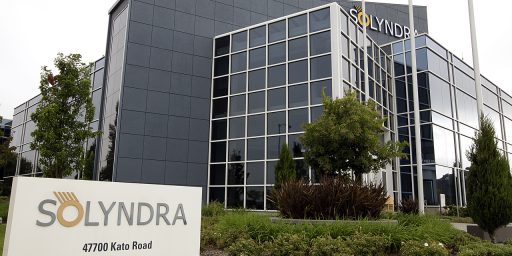
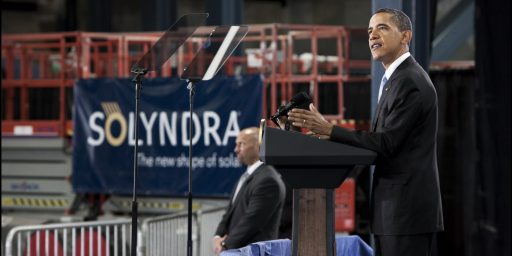
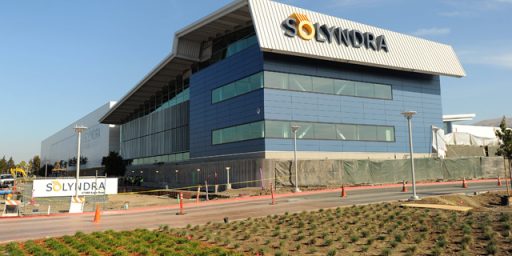

I think there are three distinct questions in this matter. You raised one of them in the closing paragraphs of your post: to what degree does this undercut the competence argument?
You allude to another in the body of the post. Were political connections instrumental in expediting the loans to Solyndra? Even if not strictly illegal it certainly appears improper.
However, there’s also a third question. Money is fungible. To what degree if at all were funds from the loans involved channeled through George Kaiser to re-election campaigns?
I think this is a genuinely unfortunate situation. Losing a half billion is bad enough but it also provides fodder for what’s likely to be a lengthy investigation.
How odd, I see another theme in the middle of that quote:
If it is true that American producers, in general, got blind-sided, then it is really important to determine if the charge that Chinese are subsidizing/dumping is true.
(Getting into a subsidy war with China was maybe kind of dumb, but for reasons totally separate from “green jobs.”)
That;’s a good point, jp. Earlier this year China dropped wind power subsidies after the U. S. filed a complaint with the WTO. It may be that solar is next.
A few companies go broke, I believe Perry had some trouble in Texas with a couple of his State’s “investments”. One of the few industries the US has a positive trade balance is Solar.
And yes we even have a positive trade balance in Solar with China.
This may seem a rejection of solar and other forms of clean energy, but the installment and use of these kinds of devices is now very widespread and common place. Mainly because it will save consumers money by decreasing utility bills. Such devices as tankless water heaters, synthetic additives to hvac systems (“Ice Cold” is one brand) that increase efficiency, hydrogen powered forklifts and other machinery, ground water based heat and a/c,: the list is very long. The point is that the clean energy product manufacture, sales,installation, and refitting business is very much alive and well. It is unfortunate that this solar company mentioned in the article went out, but that happens every day in the business world. Don’t take this as a failure of that kind of technology. As far as electric or hydrogen cars, get me one that will go ten hours on a charge, that is priced around $20,000, and the government promises no hidden “fuel” or mileage/usage tax to replace the gasoline tax, and you will have people lining up to buy them. If you are going to be in the need for a new water heater soon, consider a change over to tankless: the prices have come down, there is a tax deduction, utility costs are much lower, and you get instant hot water.
The biggest problem for the “Green Energy Industry” is that it is clean and carbon free, but there is no immediate monetary benefit for it. Meanwhile coal and oil are neither clean nor carbon free, but the costs are put off to the future where no one knows what those costs will be.
It is hard to compete when the competition is on such a slanted field.
@OzarkHillbilly:
Well, I think the problem is that “green jobs” is such a big bucket. You can throw almost anything in it. Some things do have rapid pay-off, like the switch to LED traffic lights I mentioned earlier. Efficient refrigerators have a fairly short term benefit. Well especially given that people pay much more for “fancy” refrigerators than they would for “efficient” ones.
On the other hand some “green” initiatives are really tenuous. If you build a “green” shopping mall, how many people will drive to it?
Hmm, one bankruptcy in an industry that Doug doesn’t approve of proves the entire concept of green jobs is a fiasco. The entire world economy teetering on the edge of destruction because of the reckless, criminal behavior by the country’s biggest banks and the trillions of dollars needed to save them from bankruptcy doesn’t show there’s anything fundamentally wrong with an industry of which Doug does approve — it was just a few bad apples, none of whom should be punished and all of whom should have their taxes cut.
Pretty convincing stuff here.
Ouch, a double whammy for Obama. Seems if he got his regulators under control, this might not have happened.
The owner of this company is a major Obama donation bundler. That alone qualified the company to the loan and the loan guarantee.
I’ve been in the capital providing business for about 21 years. From 1989 to 1995 as a lender. Since then as a principal. I’ve seen so many save the world “green” etc projects, and cycles it would make your head spin. “Trash to cash incinerators,” solar etc. Bust, bust, bust.
Just in the last 3 years I’d have to say we’ve seen pitches to provide capital to busted solar deals in the number of, say, two dozen, plus or minus.
There is a bottom line. Without subsidy the vast majority are not economically viable. Sorry folks. Either eat you pious words about “corporate welfare” or recognize you are part of the pigs at the trough for your personally favored ideal.
Chevy Volt, anyone?
What’s truly ironic is there are liberal idiots out there who’ll be surprised by this.
Look, solar doesn’t work. Never has worked. Never will work. You can subsidize it until the cows come home. Hell, you can subsidize it until the entire Treasury is one giant solar power investment. Still won’t work. Except perhaps in magical unicorn left-wing fantasy land.
As France and many others discovered decades ago, the renewable energy platform is nuclear. It’s clean. It’s safe. It works. It doesn’t require direct subsidies. All that’s necessary are enviromental waivers and some loan guarantees. Plus the buildout instantly would create vast quanities of high-paying jobs. Then you’d retain a large number of high-paying permanent jobs even after the buildout is complete.
Three choices: We go nuclear. We dig for more oil and develop our shale deposits. Or we transfer a large part of our national wealth and security to Middle-Eastern oil producers. Choose wisely, Mr. NIMBY.
@Tsar Nicholas: You might want to go to Google and type in the word “Fukushima.” Then we can have this conversation.
I don’t think you understand the meaning of the word ‘renewable.’
@Neil Hudelson:
You just need that long (fifteen thousand year) view. Fukushima will come back, give it time.
@Tsar Nicholas:
Actually, the green jobs initiatives usually push the wrong kinds. Some kinds of solar do work, but they are less sexy. Solar pre-heat for hot water works, reduces fuel use, and has rapid-pay back. Desert solar-thermal plants work, produce energy, and make a profit.
The thing that doesn’t pay-off, in most cases, is small solar-electric (photo-voltaic) installations on individual homes. Placement is often bad. Climate is often sub-optimal. Maintenance, including just washing them off as much as you should, doesn’t happen.
So I’d be with you that we should kill a lot of the wrong-headed projects, but you should know that good projects are out there.
Let me guess: as a Taco Bell shift manager, you’ve at times had to decide what color recycling bins to put out back.
@Tsar Nicholas:
Tell that to the Germans who live in a cold dark climate and have installed enough solar to avoid more Nuclear Power Plants. Here in Oregon we are producing PV panels that are going to both Germany and China.
Solar energy is a technology that is still a work in progress. My husband and I have had solar panels for years now, and like it. However, it was not a cheap installation, and many people simply can’t afford it.
Now, there is a company that has a program renting out it’s solar panels, which is proving to be cost-effective to more people. However, as clean as solar energy is we still need conventional sources, such as oil and gas, to fuel this country until the if/when time arrives that alternative means are able to be refined enough to replace old, established energy sources.
I’m reminded of another company, Gibson Guitar, who employs thousands of people (non-union), who was raided twice by the DOJ for infractions cited (an obscure 100 year old Lacey Law) in the wood they used. The company’s CEO was told the following by the fed:
Basically, if Gibson took their business overseas to the country they bought the wood from then the feds would go away. Now this is ironic, as, on one hand, you have a solar company subsidized by the government to hire workers and prosper, and, on the other hand, here’s a non-union American shop being harassed to take their business to another country!
Go figure!
Gary, where are you!
The Chinese subsidize solar panel production an order of magnitude beyond what we do and
Solyndra just couldn’t compete with that. You can’t have free trade with a country which is mercantilist and expect to come out ahead.
A subset of the green energy industry is electric/hybrid cars. Not so fast says this article citingthe shocking truth about electric cars.
An additional question, that our enterprising electrician friend mused over, a while back, was what to do with all those batteries when they wear out. Like nuclear waste, how do you dispose of tons and tons of car batteries?
@jan: At least some nuclear waste has potential uses as fuel in some Gen IV reactor designs…
@WR: And @Tsar Nicholas: No Kidding! But remember, all we need is “a few environmental waivers” and we’ll be swimming in electricity–or something. The guys at Exxon, among other places, are saying the same about fracking–and besides, you can’t prove that the napthalene wasn’t already in the well water (except that you can).
The NY Times has this story today: China Benefits as U.S. Solar Industry Withers:
Hard to compete in a environment shaped by that last, I’d think.
However, here’s a counter:
Solyndra Bankruptcy Wasn’t China’s Fault, Rival Solar CEO Says
@jan:
Solar technologies (plural) are evolving, but I think you chose the toughest to justify, that is photovoltaic for home installation. It is not at all the same tech as concentrating solar thermal, the current efficiency and cost leader.
@jan: You might want to learn the difference between an article and an opinion column.